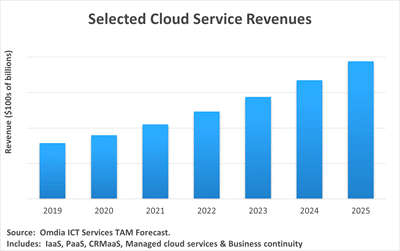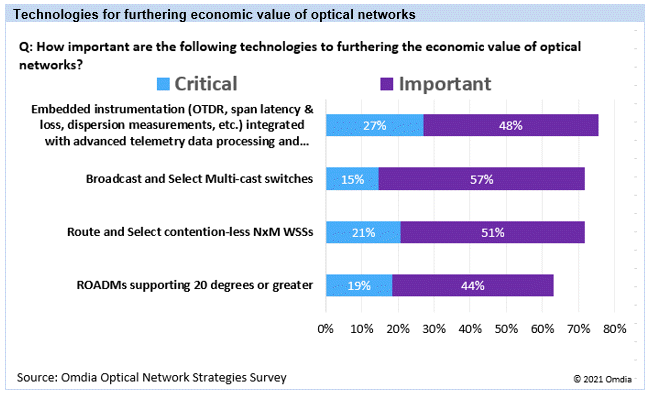A new age of IP/Optical network visibility and automation applications
 Ian Redpath is the
Practice Leader for Omdia’s Transport & Routing practice. He is responsible for strategy, client,
product and team development for one of Omdia's most advanced technology practices. Managing a team of
communications technology professionals, he covers how communications service providers, internet content
providers and enterprises utilize and deploy leading-edge optical networks, components and routing
technologies.
Ian Redpath is the
Practice Leader for Omdia’s Transport & Routing practice. He is responsible for strategy, client,
product and team development for one of Omdia's most advanced technology practices. Managing a team of
communications technology professionals, he covers how communications service providers, internet content
providers and enterprises utilize and deploy leading-edge optical networks, components and routing
technologies.
Cloud services have gained mainstream enterprise acceptance and have strong potential for additional growth including more cloud service endpoints and additional bandwidth per service. Cloud services are being accessed from anywhere – home office, enterprise site, or on the go. By shifting mission critical services to a cloud model, the performance requirements of the bandwidth underlay have been raised. Now, CSPs require enhanced visibility of service and network performance to be able to adhere to more stringent latency requirements.
5G is also catalyzing the network visibility need. It is driving the need for a huge volume of high bandwidth IP/Optical endpoints. Stringent latency specifications and enhanced network visibility are sharpened in the 5G era. 5G necessitates multi-layer 0-3 visibility to the cell site.


Cloud and 5G services will run over a converged IP/Optical infrastructure. Optical networks are rapidly scaling, approaching 10 million optical coherent ports in operation. They are also evolving in terms of reach to meet the cloud and 5G endpoint densification needs and to support modern architectures with distributed edge compute.
CSP Challenge: Operating efficiently in a rapidly scaling environment
As I mentioned above, the cloud service growth, 5G RAN growth and optical capacity expansion to the edge are driving a further CSP need: vastly improved network management, visibility, and automation. If IP and optical network technology layers must operate in close concert, then once-independent network management solutions must also operate in a more tightly coordinated manner. Tighter multi-layer integration also entails greater multi-vendor interoperability in the network management domain, as CSPs typically work with at least two vendors in every layer in the network. The management of the network needs to be faster. CSPs’ desire and direction of travel is to move from a manual human-operated era, through an auto-assist era, and ultimately onto the fully automated era.
CSPs also need to evolve from the historical reactive stance on fault management to a more proactive footing of predicting faults prior to service affecting events. CSPs look to leverage the latest predictive capabilities enabled by detailed network telemetry and data analytics algorithms.
The automation imperative from a CSP perspective
In the recent, “Omdia Optical Network Strategies Survey”, a key question posed was: “What is key for future value for optical networks?”. The top point cited by the CSPs was: “Embedded instrumentation and being able to process advanced telemetry data.”

![]()
In addition to leveraging embedded instrumentation for advanced control, future network
management solutions must align with CSPs’ broader vision:
- to accelerate the revenue line and take control of the operational cost line
- to implement true multi-layer network management integration
- a “single pane of glass” for multi-layer, multi-vendor service and network visibility
- to evolve from reactive network management to a more predictive mode of operation
- to leverage new advanced analytical capabilities
- to progress towards the ultimate goal of closed loop automation
- to evolve to an optimal state of network efficiency
Foundations for integrated IP/Optical network visibility & automation
The next generation multi-vendor IP/Optical network management platform draws upon progress in three foundational areas in order to move from manual methods to data-driven automated operations:
- More network performance data is available from the historically opaque optical layer
- Open APIs provide the common language for multi-layer and multi-vendor communication
- A growing practical suite of applications leveraging the tighter layer 0-3 interworking
More optical telemetry data available for real time state information
More telemetry data is available from the optical layer than ever before via the proliferation of embedded OTDRs and coherent chipsets. Real time optical performance can be monitored, so more key metrics can be tracked such as, effective signal to noise ratio, chromatic dispersion, pre-FEC bit error rates and latency. The enhanced optical visibility can be extended from the optical core to the optical edge.
“Open APIs” are central to network visibility and operations automation
Open APIs such as Netconf, GPRC, OpenConfig and Restful API, now can be utilized to share performance data in a non-proprietary manner. Via Open APIs, network monitoring, service monitoring and traffic engineering data can be sent northbound, from each layer 0-3 device in the CSP’s network, irrespective of the vendor. CSPs will now have a more comprehensive view of the current state of the network across layers and vendors. Open APIs, such as TAPI, WebSocket and Restful API, are equally important for integration of domain controllers with backend operational support systems (OSS). This allows for end-to-end automation of operational workflows.
Practical applications delivering immediate benefits
With a more complete network view, CSPs can take advantage of a growing suite of advanced data analytics and applications across layers. For example, with real-time visibility of optical line system SNR margin, CSPs can convert margin into optical capacity on demand as needed. Visibility of multi-vendor IP/MPLS networks and analysis of routing behavior can be correlated with performance metrics to better assure IP services. And network utilization metrics across layer 0-3 can highlight capacity exhaustion or underused resources, to improve future capacity planning.
The direction of travel: from manual to auto-assist to fully closed loop
CSPs are eager to embrace a more automated environment with detailed network visibility. The ultimate long term network management goal is a fully autonomous network: self-sensing, self-adjusting and self-optimizing, with a fully closed loop capability.
An example CSP that is already moving towards this goal, aided by Ciena’s Manage, Control and Plan (MCP) domain controller, is Windstream in North America:
"As we prepare for 5G, our wireless backhaul customers need a reliable and scalable network to realize the opportunities of this next chapter of digital innovation. With comprehensive network management and automation delivered by Ciena’s Manage, Control and Plan (MCP) domain controller, we have world class fiber-to-the-tower infrastructure and end-to-end orchestration in place to deliver high-bandwidth services to our customers with utmost agility.
 Windstream has also been a key proponent of enhanced network visibility through the multiple
network layers. We’ve been working closely with our equipment vendor partners to enhance their
equipment’s ability to provide us access to key data. We’re taking this and incorporating into
our customer facing Network Intelligence portal which is providing Layer 0 and Layer 1 analytics plus other
functionality. We recently conducted a managed spectrum trial and exposed near real-time Layer 0
insights such as OSNR, chromatic dispersion, and differential group delay through this portal. We believe
that providing and using more optical telemetry data is key to the future of optical
networking."
Windstream has also been a key proponent of enhanced network visibility through the multiple
network layers. We’ve been working closely with our equipment vendor partners to enhance their
equipment’s ability to provide us access to key data. We’re taking this and incorporating into
our customer facing Network Intelligence portal which is providing Layer 0 and Layer 1 analytics plus other
functionality. We recently conducted a managed spectrum trial and exposed near real-time Layer 0
insights such as OSNR, chromatic dispersion, and differential group delay through this portal. We believe
that providing and using more optical telemetry data is key to the future of optical
networking."
- Buddy Bayer, Chief Network Officer, Windstream
CSPs can begin the journey today and immediately take advantage of many new auto-assist capabilities and positively
move the needle on revenue acceleration and operational performance.



